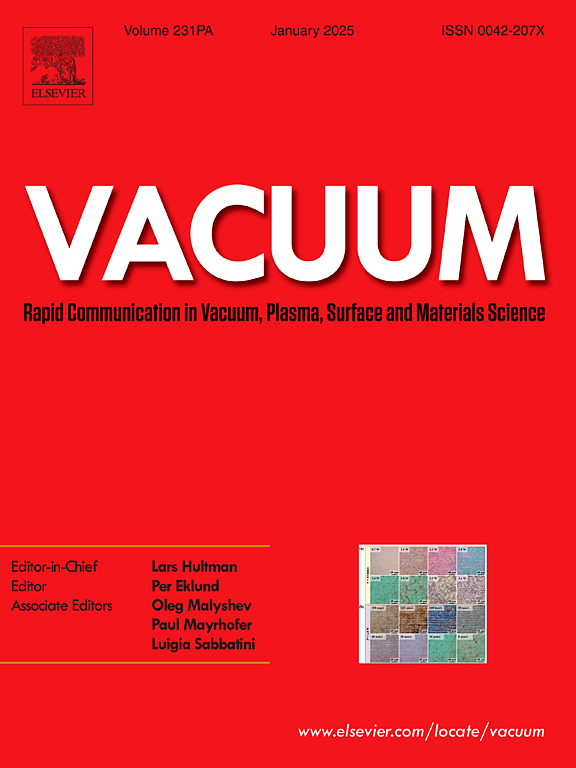(Ti, M)2AlC (M=Zr, Nb, Ta, Mo, W) 的高熵六组分 Ti 基 MAX 的合成与 DFT 计算
IF 3.8
2区 材料科学
Q2 MATERIALS SCIENCE, MULTIDISCIPLINARY
引用次数: 0
摘要
采用熔盐屏蔽法(MS3)合成了高熵六组分ti基MAX相(Ti0.5Nb0.15Zr0.1Mo0.1Ta0.1W0.05)2AlC,该相具有优异的抗腐蚀化学稳定性。透射电子显微镜(TEM)和能谱分析(EDS)证实了Ti2AlC元素的均匀分布和扩大的(004)面间距(0.352 nm比0.331 nm),与密度泛函理论(DFT)计算一致。通过电子结构分析和缺陷动力学研究了其稳定性增强机理。DFT计算表明,M位的高熵掺杂通过过渡金属d轨道(Nb/Zr/Mo-4d, Ta/W-5d)和C/Al轨道之间的杂化强化了M- Al键,将Al空位形成能从2.26 eV (Ti2AlC)提高到2.83 eV (HE-MAX)。Al空位迁移能达到1.07 eV,比Ti2AlC (0.77 eV)高39%,有效抑制了缺陷介导的降解。这些双重机制支撑了HE-MAX对HF/NaF-HCl蚀刻的卓越抗性,为极端环境下设计稳定的MAX相位提供了见解。本文章由计算机程序翻译,如有差异,请以英文原文为准。
Synthesis and DFT calculations of high entropy six-component Ti-based MAX of (Ti, M)2AlC (M=Zr, Nb, Ta, Mo, W)
High-entropy six-component Ti-based MAX phase (Ti0.5Nb0.15Zr0.1Mo0.1Ta0.1W0.05)2AlC was synthesized via molten salt shielding synthesis (MS3), demonstrating exceptional chemical stability against corrosive etching. Transmission electron microscopy (TEM) with energy-dispersive spectroscopy (EDS) confirmed homogeneous elemental distribution and expanded (004) interplanar spacing (0.352 nm vs. 0.331 nm in Ti2AlC), consistent with density functional theory (DFT) calculations. The stability enhancement mechanism was investigated through electronic structure analysis and defect dynamics. DFT calculations revealed that high-entropy doping at M-sites strengthens M − Al bonds via hybridization between transition metal d-orbitals (Nb/Zr/Mo-4d, Ta/W-5d) and C/Al orbitals, increasing Al vacancy formation energy from 2.26 eV (Ti2AlC) to 2.83 eV (HE-MAX). Additionally, Al vacancy migration energy surged to 1.07 eV, 39 % higher than Ti2AlC (0.77 eV), effectively suppressing defect-mediated degradation. These dual mechanisms underpin the remarkable resistance of HE-MAX to HF/NaF-HCl etching, offering insights for designing stable MAX phases for extreme environments.
求助全文
通过发布文献求助,成功后即可免费获取论文全文。
去求助
来源期刊

Vacuum
工程技术-材料科学:综合
CiteScore
6.80
自引率
17.50%
发文量
0
审稿时长
34 days
期刊介绍:
Vacuum is an international rapid publications journal with a focus on short communication. All papers are peer-reviewed, with the review process for short communication geared towards very fast turnaround times. The journal also published full research papers, thematic issues and selected papers from leading conferences.
A report in Vacuum should represent a major advance in an area that involves a controlled environment at pressures of one atmosphere or below.
The scope of the journal includes:
1. Vacuum; original developments in vacuum pumping and instrumentation, vacuum measurement, vacuum gas dynamics, gas-surface interactions, surface treatment for UHV applications and low outgassing, vacuum melting, sintering, and vacuum metrology. Technology and solutions for large-scale facilities (e.g., particle accelerators and fusion devices). New instrumentation ( e.g., detectors and electron microscopes).
2. Plasma science; advances in PVD, CVD, plasma-assisted CVD, ion sources, deposition processes and analysis.
3. Surface science; surface engineering, surface chemistry, surface analysis, crystal growth, ion-surface interactions and etching, nanometer-scale processing, surface modification.
4. Materials science; novel functional or structural materials. Metals, ceramics, and polymers. Experiments, simulations, and modelling for understanding structure-property relationships. Thin films and coatings. Nanostructures and ion implantation.
 求助内容:
求助内容: 应助结果提醒方式:
应助结果提醒方式:


